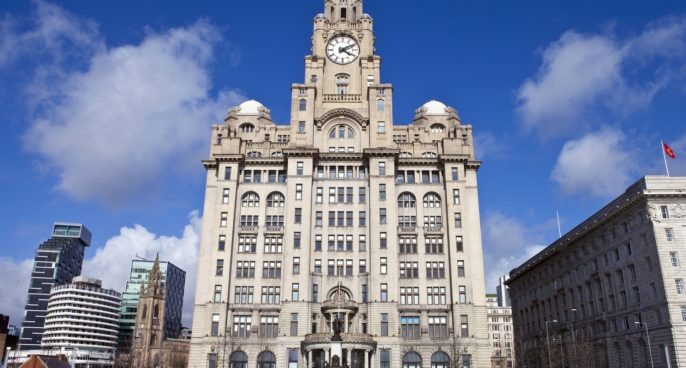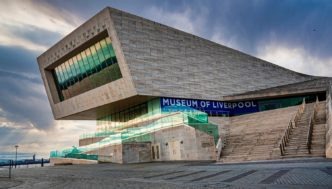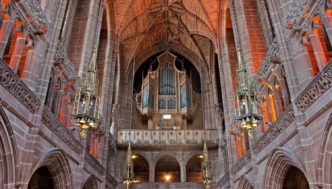
When it comes to architecture, Liverpool boasts some of the most beautiful buildings in Britain. Without a doubt, the Liver Building Liverpool is a national treasure. It’s part of a harbourside trio built in the early 1900s and is a beloved local landmark. Together, the trio helps make the Liverpool skyline one of the most impressive in the country.
The story behind the building is fascinating, which is why we’ve dedicated an entire post to the Liver Building construction. Read on as we dive deep into the history of the iconic structure, answer all your questions about the Liver Building Liverpool and touch on our own construction site services in Liverpool.
Table of Contents
- 1 The Three Graces
- 2 Who designed the Liver Building?
- 3 When was the Liver Building built?
- 4 Why is the Liver Building famous?
- 5 How many Liver Birds are there?
- 6 The Liver Building today
- 7 Visiting the Liver Building Liverpool
- 8 The Royal Liver Building Clock
- 9 Honouring a Liverpool city icon
- 10 Our role in the boom
The Three Graces
Together with the Cunard Building and the Port of Liverpool Building, the Royal Liver Building is part of a trio known as the Three Graces. Built in the early 1900s, the Three Graces have towered over the Liverpool waterfront for almost a century.
The majesty of the buildings is no coincidence. All were designed and constructed to celebrate the international power and prestige Liverpool enjoyed in the early 1900s. As such, all three buildings capture the rich maritime heritage of the city, and the Royal Liver Building is the jewel in the crown.
Who designed the Liver Building?
Famed English architect Walter Aubrey Thomas designed the Liver Building Liverpool. His brief? To design a trio of commercial buildings that captured the wealth, power and prestige of the city. The building would become HQ for the Royal Liver Assurance, which was established in 1850 to provide insurance policies to locals.
The Liver Building Liverpool isn’t the only legacy left by Walter Aubrey Thomas. You’ll see his masterworks across the city. Other gems include New Zealand House on Water Street, The Lord Street Arcade and the heritage-listed Tower Building on The Strand. All showcase the incredible talent of Walter Aubrey Thomas and the role he played in transforming the Liverpool skyline in the early 1900s.
When was the Liver Building built?
Liver Building construction started in 1908 and continued until 1911. Over the course of three years, a team of skilled craftspeople brought the vision of Walter Aubrey Thomas to fruition. After completion, more than 6000 Royal Liver Assurance employees moved into the building.
The Liver Building Liverpool commemorated its 100th anniversary in 2011 and celebrations were suitably grand. Colourful, three-dimensional projections were cast onto the façade of the Liver Building Liverpool and brought its legacy to life.
“This is going to be a fabulous weekend and I can’t think of a better way to celebrate this building which pushed the radical boundaries when it was built by using the latest, innovative technology,” said Liverpool City Council cabinet member, Wendy Simon.
Why is the Liver Building famous?
While today reinforced concrete is a widely used building and construction material, in the early 1900s it was cutting edge. The Liver Building construction project was one of the first in the world to utilise reinforced concrete. This novel material allowed Walter Aubrey Thomas to design a safe and sturdy building almost 100 metres tall. The incredible proportions made it one of the first skyscrapers ever built in Europe.
When Walter Aubrey Thomas first revealed plans for the Liver Building Liverpool, his designs were considered radical. Some even warned the sheer size and scale of the building would make construction impossible. Little did they know, reinforced concrete would reimagine the limits of building and construction in Liverpool.
Envelope-pushing architecture
Reinforced concrete is pretty amazing stuff. So, let’s take a moment to cover the material in more detail and explore how it was used in the Liver Building construction. Also known as reinforced cement concrete, the composite material is coveted for its strength and durability. When used alone, concrete has fairly low tensile strength. This means it can’t endure much stress before breaking. Concrete also has relatively low ductility. This mechanical property describes the ability of a material to deform without fracturing.
Reinforced concrete uses support like steel bars to improve the tensile strength and ductility of the material. Support beams are embedded in the concrete before it sets and significantly bolster the strength, durability and flexibility of the material.
Walter Aubrey Thomas was one of the first architects in Europe to embrace reinforced concrete. It was ultimately what allowed him to design such a spectacularly large monument and pull off his Liver Building construction vision.
How many Liver Birds are there?

Of all the icons and emblems you’ll see around Liverpool, the Liver Birds are the most famous. The dynamic duo are perched atop the building and steeped in local folklore. One Liver Bird overlooks the Mersey River and symbolises the wives who stayed at home and cared for the family while their sailor husbands worked at sea.
The second Liver Bird watches over the city and symbolises the sailors who yearned to return to Liverpool and their families. There’s also a slightly cheekier version where the male bird is squinting inland to see if the Liverpool pubs are open. Meanwhile, the female bird has her eyes on the horizon to see if any handsome sailors are docking in town.
Fun fact: the birds have been named Bella and Bertie by locals. While we don’t know why for sure, there’s a rumour that Bella was named after Isabella of Angouleme. She was queen consort of King John of England when Liverpool was awarded a Royal Charter in the 13th century. Bertie also has a royal connection. He is possibly named after King Edward VII, who was affectionately known as Bertie by his family. Edward VII was on the throne at the time of the Liver Building construction.
Designing the Liver Birds
At 5.5 metres tall, the Liver Birds are larger than life. German-born sculptor Carl Bernard Bartels designed the birds, which are made from solid copper. Artisans at the Bromsgrove Guild of Applied Arts created the birds and executed his vision. According to local legend, if the two birds were to take flight and disappear, Liverpool would no longer exist. Good thing they’re both cast from solid copper!
While the birds atop the Royal Liver Building are the most famous, you’ll see others dotted across the city. As you walk around Liverpool, look out for birds perched on the sides of buildings, watching over doorways and incorporated into business logos.
Liver Building FAQ
- The Royal Liver Building is 98.2 metres tall if you measure from the ground to the top of the spires.
- Add the birds and the Royal Liver Building is an impressive 103.7 metres tall.
- Each Liver Bird weighs a mighty 4 tonnes.
- At the time of Liver Building construction, the building was one of the tallest in the country. It retained its crown until 1961.
- The Liver Building Liverpool has 13 floors in total.
The Liver Building today
Today, the Liver Building Liverpool remains a working commercial space for globally recognised companies like Princes and Grant Thornton LLP. It’s also utilised by mortgage companies, media groups and other entities. On the first floor is The Venue, a sleek space used for corporate meetings, private parties and other events. While the building has taken on multiple different roles over the years, it’s always been the heart and soul of the Liverpool economy.
Who owns the Liver Building?
In 2016, the Royal Liver Building went up for sale for the first time in history. Commercial real estate giant CBRE Group was commissioned to list the property, which had an estimated value of £40 million. In 2017, Luxembourg-based real estate investment company Corestate Capital purchased the building. It sold for above market value at £48 million.
Farhad Moshiri, a prominent British-Iranian businessman who owns a majority stake in Everton F.C, was also involved in the transaction. He planned to manage the football club from the building and work from an office with views over the new Bramley Moore Dock stadium.
Visiting the Liver Building Liverpool
Unsurprisingly, members of the public are captivated by the Liver Building Liverpool. In the past, it’s only been possible to admire the building from street level or go behind the scenes on Heritage Open Days. In 2019 this changed thanks to the addition of a visitor attraction in the West Clock Tower. For the first time in history, members of the public were invited to tour the West Clock Tower.
From the viewing platform, you’ll get panoramic views over the Liverpool skyline and the River Mersey. It’s an incredible experience and something we’d 100% recommend doing, whether you’re a local or a visitor. You’ll pretty much get the same views as Bella and Bertie!
More recently, the Liver Building Liverpool and its fellow compatriots have formed a dramatic backdrop for a ‘Maritime Tribute’ to Queen Elizabeth II. Around 20 ships gathered on the River Mersey in front of the Three Graces to pay tribute to the monarch. The buildings have also been lit up in purple to honour Her Majesty the Queen.
The Royal Liver Building Clock

A pair of clock towers crown the Liver Building Liverpool. They’re visible from the River Mersey and designed to help sailors tell the time when sailing past. The clock faces are enormous and measure an impressive 7.6 metres in diameter. This makes them larger than the iconic Great Westminster Clock in London.
Like the rest of the Liver Building Liverpool, the clocks also have a royal connection. They’re nicknamed George clocks as they were started at the exact moment George V was crowned as King. For the record, the coronation took place on June 22, 1911.
Honouring a Liverpool city icon
A lot has changed since the Liver Building Liverpool was officially opened in 1911. The Royal Liver Assurance was absorbed by the Royal London Group, The Beatles took the world by storm and legends like Bill Shankly, Kenny Dalglish and Steven Gerrard have helped shape the face of Liverpool F.C.
Building and construction in Liverpool has also continued to boom. While Walter Aubrey Thomas may no longer be designing monuments, new developments like The Keel at Queen’s Dock, The Lexington at Princes Dock and Paddington Village in the Knowledge Quarter are fuelling citywide growth.
From luxury hotels along Parr Street to residential apartments in the Baltic Triangle, new builds are transforming the face of modern Liverpool. New homes, apartment blocks and retail complexes are also popping up across the suburbs. The city is also fiercely protective of its historic architecture, which means there are loads of renovation and conversion projects underway.
Our role in the boom
We’re excited to be a part of the urban growth and to ensure building and construction workers in Liverpool have access to clean, comfortable and hygienic welfare facilities. Nature called during the Liver Building construction in the early 1900s and it still calls today!
Of course, we’re happy to say things are a lot cushier these days. We offer a wide range of portable toilets for hire in Liverpool designed to meet the needs of modern building sites. From mains-connected flush toilets and single hot shower units to complementary products like freshwater drinking tanks and site fencing, we have it covered. No matter the size or scale of your project, our team can help you run a safe, comfortable and aboveboard construction site.
Why worry about welfare facilities?
With clean and regularly serviced welfare facilities, you’ll enjoy total peace of mind your construction site meets HSE standards. Access to clean and modern welfare facilities is also a guaranteed way to boost workplace productivity and improve employee morale. We’d love to help, so get in touch today to discuss your needs and request a quote.
One thing that hasn’t changed over the past century? The beauty and grandeur of the Liver Building Liverpool. Together with the Cunard Building and the Port of Liverpool Building, the Three Graces have been beautifully maintained over the years. We’re proud to operate in Liverpool and step up as local custodians of this architectural jewel.



